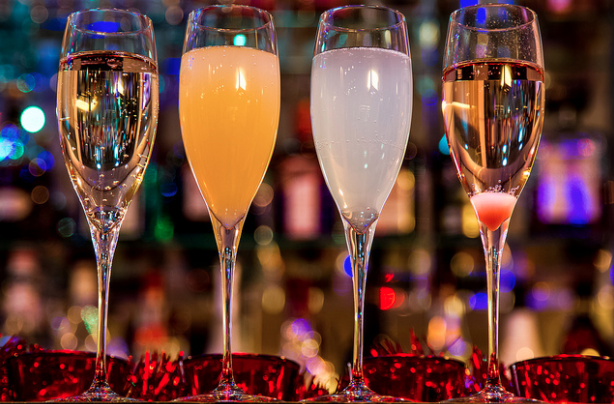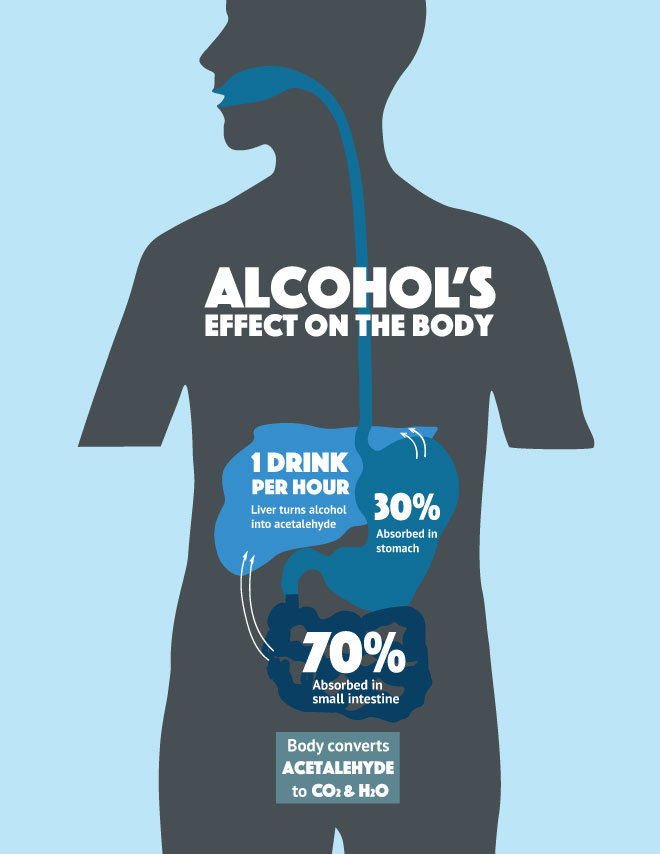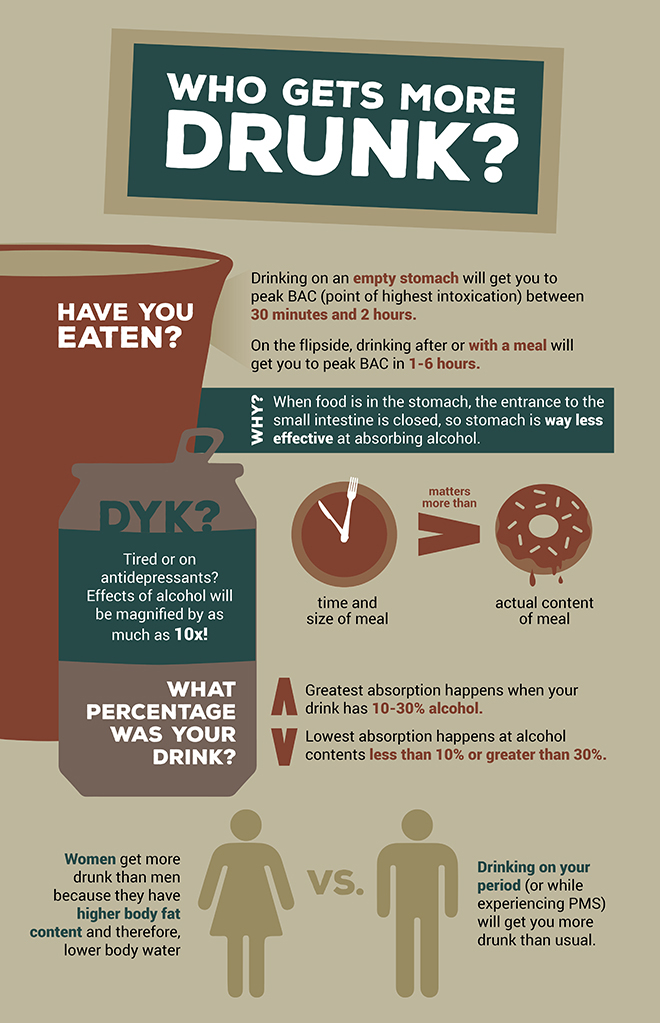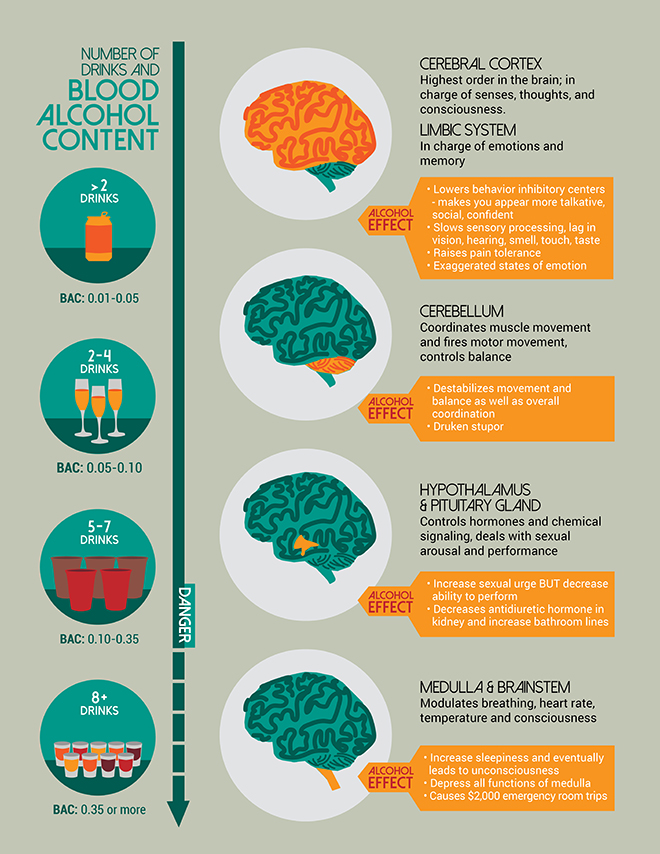
It’s finally the weekend; you are taking a break from your stress-ridden classes and relaxing. It’s 9 p.m. and you’re looking to have a great time tonight. Here’s how your night went down through the lens of science (the last thing you want to think about right now).
You arrive at your first pre-game and see the Skol and cheap tequila lining an unclean and cluttered counter. You take the first shot glass in sight, sticky and already used by a stranger, but you pay no mind and pour yourself a shot – one standard drink – and knock it back as fast as you can without gagging.
What happens now?

Once you swallow, the drink goes into the stomach, and then the small intestine. Small blood vessels carry it from the stomach and small intestine into the bloodstream. The stomach absorbs 20-30 percent of the alcohol and the rest is absorbed through the small intestine. Alcohol is then metabolized by the liver, where enzymes break it down into acetaldehyde, which is recognized as a toxin by the body. It is then broken into carbon dioxide and water, which is able to be flushed out by the body. For those of you who might get “asian glow” — the absence of the mitochondrial aldehyde dehydrogenase (ALDH2) enzyme that is responsible for converting acetaldehyde to acetate is actually what turns your cheeks red. This results in an overaccumulation of acetaldehyde which is pretty bad for you. The “glow” is actually a warning to STOP drinking. The liver can only handle one ounce of liquor (one standard drink) per hour; more than this, and the alcohol will build up in the blood and body tissues until it can be processed. Since only 2-5 percent of alcohol can be excreted by the lungs, sweat and urine, drinking lots of it can result in a high BAC (blood alcohol concentration) for many hours.
When does the drunkenness set in?

For someone who has not had anything to eat recently, peak BAC (or the drunkest you can get) happens between 30 minutes and 2 hours. For someone who has, it will take 1 to 6 hours. Why? When food is ingested shortly before or with the alcohol, the pyloric valve at the bottom of the stomach is closed in order to digest food. In doing so, it stops the alcohol from going into the small intestine where absorption is the most effective. The stomach absorbs alcohol much slower. The content of the food (fat, carbs, protein) does not really play a big role in absorption — the size of your meal and time between the meal and your first drink matter more. As the alcohol moves from your bloodstream to your liver, it takes the liver one hour to fully process the alcohol. The strength of your drink will also play a role in how your body absorbs it. The highest absorption rate for alcohol happens when your drink contains 10 to 30 percent alcohol, and is slower when the percentage is less than 10 or greater than 30. This is because when the content is greater than 30 percent, it irritates the mucous membranes of the gastrointestinal tract, causing mucous production to increase and slowing down the absorption of alcohol. Body fat percentage is a factor as well. Those with more body fat have lower percentage of body water, leading to a higher BAC when given the same amount to drink. This is why women get drunk faster than men, because women tend to have higher body fat content. Because of this, if you work out a lot and are very muscular, you will get drunk slower. If you are larger or heavier, you will get drunk faster than your lighter and smaller friend. For females, if you are drinking while PMS-ing, you will get drunk faster than normal. It is shown that women have more of the enzyme that breaks down alcohol, and thus can process it up to 10 times faster than men. This also leads to a faster and higher BAC.
Also note: If you’re tired or on antidepressants, the effects of alcohol will magnify by as much as 10 times.
Now, if you’re not a fan of shots and fancy yourself a nice mixed drink, what you add with the alcohol may get you drunk faster. The addition of the unfamiliar mixer may enhance the effects of alcohol. In a study published in Addictive Behaviors, if you try to mask the taste of alcohol, you will show more signs of intoxication than if you drink the alcohol as is (in the form of a beer, a shot, etc.). Cutting calories in your mixer may also increase your BAC. National Institutes of Health reported that artificial sweeteners such as those present in diet drinks lead to higher BAC than regular drinks.
Funny enough, your brain is also a big fan of playing drinking games. If you set out to “get plastered” you will feel more drunk faster with the same amount of alcohol than if you were thinking, “I need to stay sober.” Studies have also shown that if you are around people who are hammered, you’re more likely to feel hammered yourself. Additionally, a carbonated mixer will get you more drunk than a flat mixer, as carbonation has been shown to increase the absorption rate of alcohol.
This is your brain on alcohol.
Why do you start acting funny? What does the alcohol do after it’s absorbed and before it’s processed? Alcohol messes with your nerve cells and neurotransmitters by interrupting their communication. It suppresses the activities of the excitatory nerve pathways and increase inhibitory nerve pathway activities. This could account for the fact that alcohol makes you sluggish. Alcohol also affects various centers in the brain, from higher to lower order functions, and not equally. The higher order centers are more sensitive, but as BAC increases, the amount of centers affected increases as well. The centers of your brain are affected in the following order: cerebral cortex, limbic system, cerebellum, hypothalamus and pituitary gland, medulla. The effects of alcohol are cumulative, like most science finals.
What happens as each center is affected?

The cerebral cortex is the brain's first line of defense and is affected at BAC of .01 to .05. It’s the highest order in the brain and is in charge of processing information from your sense and “thoughts” as well as your consciousness and a majority of your voluntary muscle movements. Alcohol lowers the threshold to your behavioral inhibitory centers which makes you appear more talkative, social and confident. It also slows down information processing from your senses, which explains the lag in vision, hearing, smell, touch, and taste. Your pain tolerance is also raised so you could fall a million times and not feel it until the next morning. Thought processes are also inhibited, which means you will likely not use good judgement or think things through rationally.
The limbic system is up next. It’s made up of the hippocampus and the septal area, and manages emotions and memory. As alcohol seeps in, you’re prone to exaggerated states of emotion – from anger to aggression to sadness – and memory loss, but more on that later.
At BACs of .05 to .10 (about 1-2 drinks in, 3-4 for those with higher body water percentage), the cerebellum is next in line. This center is in charge of coordinating muscle movement, especially fine movements such playing an instrument or even writing. It is also in charge of balance, which explains why you can’t walk in a straight line and are constantly falling over in a drunken stupor.
At BACs of .20 to .35 (5 to 7 drinks in), the effects on the previous brain centers become more pronounced, but the new effects on the hypothalamus and the pituitary gland are the most interesting. The hypothalamus controls sexual arousal and performance, but as BAC levels increase, it creates a paradox of increasing sexual behavior but decreasing ability to perform. Alcohol also decreases the level of antidiuretic hormone in your kidney, which explains the frequent bathroom breaks and the long lines in bar bathrooms.
At BACs of .35 or higher (8 or more drinks), the medulla is the last stop for alcohol and a stop that is dangerous to make. The medulla, or brainstem, controls breathing, heart rate, temperature modulation and consciousness. When alcohol gets to the upper centers of the medulla, you will start to feel sleepy and eventual become unconscious. If BAC continues to rise, it will eventually depress all functions of the medulla, a point you obviously never want to reach. This is where all those scary $2000+ ER trips happen.
Besides affecting the brain, alcohol irritates the linings of the stomach and intestine, which causes vomiting. It increases blood flow to the skin, which may make you feel hot, but actually lowers your body temperature. It also reduces blood flow to the muscles, which causes muscle aches the next morning.
I know what you did last night, but do you?
You know when you wake up in a panic, having no idea how you got home, or why there’s an empty pizza box by your bed? Well, alcohol-induced amnesia is common when you drink in huge gulps or drink on an empty stomach. There are two types of blackouts: en block blackouts and fragmentary blackouts (browning out). En bloc blackouts happen when your short term memories are unsuccessfully consolidated to your long term storage, and it occurs when alcohol interferes with receptors in the hippocampus that transmit glutamate, a chemical responsible for neural communications in the region. The person is able to engage in conversations, partake in activities and appear engaged. This is because the short term memory is functioning okay, but since these memories were not properly transferred, they cannot be recalled under any circumstances. Browning out, or having fragmentary blackouts, happen when memory transfer is only partially blocked. This creates bits and pieces of missing parts in your recollection of last night, but given the right prompting and stimulation, you may be able to recover your missing memories.
After party at Burger King
It’s almost the end of the night. You’re getting ready to head back and suddenly, you and all of your friends are craving something greasy, cheesy and hot. North campus folks tend to congregate at Lisa’s or order pizza, and south campus folks head to Cheesie's, BK or Fran’s. Why the drunchies? Researchers at Northwestern University showed that alcohol makes people more relaxed and more likely to indulge. This, in addition to the fact that blood sugar levels in the body are low due to the liver focusing mainly on getting rid of alcohol and the fact that your inhibitions and rational decision making centers are sidelined, would explain why junk food appeals to you so much.
The morning after
You saunter off to bed, and most likely wake up very early in the morning before falling back to sleep. Why are you up? Alcohol consumption most likely disturbed your body’s circadian cycles by altering the normal production of hormones and chemicals. For example, adenosine production increases as your drink, allowing you to fall asleep very easily. But it subsides quickly and you are woken before you are truly rested. Alcohol can also decrease your quality of sleep by blocking REM sleep – the deep, restorative stage. Due to these factors, you might feel groggy and unfocused the next morning.
If you’re the lucky few that has yet to experience the pain that is a hangover, then hang onto your lucky stars. Those who get Asian flush are also more susceptible to hangovers, and those who are smaller and lighter are more susceptible as well. Why we get hangovers is still a mystery to most scientists. Theories range from simple dehydration to effects on metabolic abilities of the body to the buildup of acetaldehyde to the triggering of cytokines which prompt immune inflammatory responses. It has been statistically found, though, that the type of drinks you have and how many drinks you have all play a role in if you get a hangover and how severe it is. While there are many tried and true hangover cure testaments, there’s no scientific cure yet. The one thing you should not do is take Tylenol (an acetaminophen).
At the end of the day, alcohol is not a magic potion. It’s just a simple chemical that evokes predictable responses in the body. As long as you know what you’re doing with your night out and what your night out is doing to you, stay safe and party on!